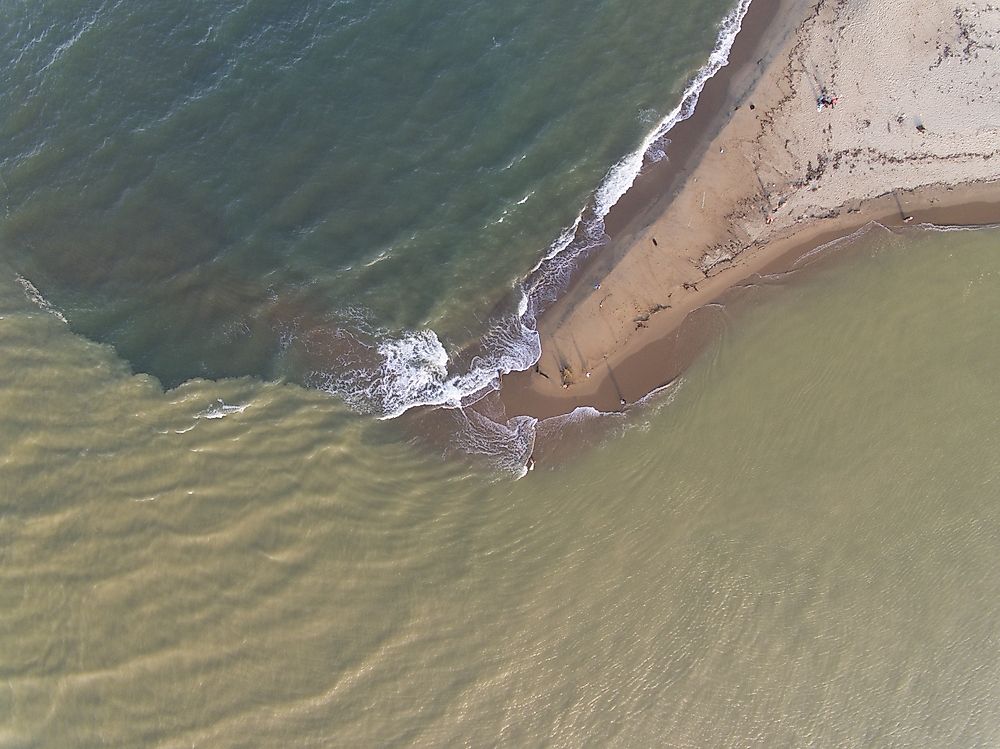Why is the Ocean Salty?

Ocean water contains dissolved salt substances which make it saline. These are soluble compounds of potassium nitrate, sodium chloride, and bicarbonate. The ocean is about 97% salt. This means salinity is almost steady and that it cannot go beyond that percentage. Salts was deposited in the ocean through various ways over billions of years ago. The salt collected accumulated steadily until ocean water became almost saturated with the salt content. The average salinity of ocean water is 35 g/kg. The degree of saltiness of ocean water is called salinity.
Factors of Ocean Salinity
The factors that led ocean water to be saline are:
High Temperatures
Extreme high temperatures make surface water in the ocean evaporate. But dissolved minerals containing salt substances do not evaporate. This makes ocean water to have a higher level of salt content. Ocean water in the tropics is more saline than in polar regions because the sun is higher and evaporates higher, making it have higher salt concentration. Salinity decreases from the tropics towards the poles. Evaporation of ocean water within the equator is slow since there is high rainfall which dilutes salts that accumulate on the surface of the water after high evaporation. In this regions temperature is warm, and the air is not moving, hence the vapor saturates the atmosphere above, preventing more evaporation. This makes the ocean water in the equator regions less saline.
Inlet and Outlet Drainage
Salt is added to the ocean through inlet draining, rainwater, and surface runoff. As river water flow over rocks and minerals, some minerals like limestone dissolve in water. The dissolved mineral substances are carried downstream in solution form to the ocean. Similarly, rainwater percolates through the rocks and dissolves them through weathering. These dissolved minerals reach the stream and flow to the ocean increasing salt content in the surface of the sea. Salts can also get to the sea through surface run-off. When it rains highly in the areas around the coast, it floods and flows towards the ocean. Rainwater combines with carbon dioxide to form weak carbonic acids, and as this water flows on the surface, it dissolves minerals that come in contact with it. Dissolved mineral and salt substances are carried in solution form to the sea. The only way that water gets out of the ocean is through evaporation, leaving behind salts.
Volcanic Activities
Sometimes volcanic eruption is taking place in mid-ocean ridges, and some of these crustal rocks are compounds of salts. Soluble erupted rocks are deposited at the base of the ocean which adds salinity to water in the ocean. Hydrothermal vents in the ocean ridges are very hot, hence dissolves rocks in the oceanic crust which contain a lot of salts and minerals making ocean water saltier.
Low Rainfall
Rainwater dilutes the concentrated salts in the ocean water. Parts of the ocean that do not receive heavy rainfall remain more highly saline. This happens mostly in hot and dry regions. In these areas, winds are accompanied by storms which carry away the vapor in the atmosphere above the sea creating room for more evaporation. The gas which could have condensed above the ocean and fall as rain is carried away by these high winds leading to low or no rainfall. This phenomenon has constituted to high salt level in the ocean.
Will Ocean Water Become Saltier Over Time?
Statistics show that the salt content in most of the oceans has not changed over billions of years. This means it has attained a steady state where no more significant change will be noticed. In fact, the salt content is likely to reduce since most of the countries are planning to extract minerals from deep within the ocean as hydrological processes produce new salts in the bed of the ocean. Thawing action also helps in reducing salt content in the ocean since the ice melting in polar regions produce fresh water which dilutes accumulated salts. Tectonic system and leaching of some compounds likely reduce the salt content in the bed of the ocean.
Role of Salt Water
Salty water affects the movement and composition of ocean water as saline water is denser than fresh water. Salinity also affects the distribution of aquatic life like fish and mangrove plants. It also affects elements of water like humidity, temperature, and solar insolation.
Are Rivers Salty?
Not all the rivers flowing into the sea are salty. Rainfall and glacial melt provide river water, which is why it is not salty. Freshwater rivers will not affect the whole ocean but have a slight change in their mouths. Salinity is a bit reduced at the mouth of these freshwater streams.
Do All the Oceans Have the Same Salt Content?
Various oceans like Indian Ocean, Pacific Ocean, Atlantic Ocean and others have different levels of salinity since they are located in different latitudes and longitudes, and climatic conditions. Oceans near the equator are less saline compared to the ones within the tropics where rainfall is much lower than in equator. Oceans in polar regions are not much alkaline because of a lot of fresh water from melting ice. Salt content of the oceans depends on their geographical location.











